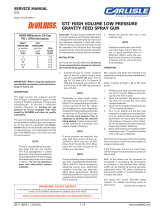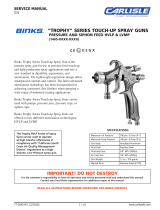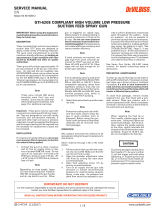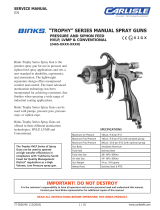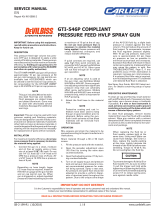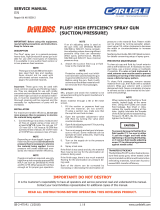Page is loading ...

SB-2-548-R2 (3/2019) 1 / 10 www.carlisleft.com
IMPORTANT! DO NOT DESTROY
It is the Customer's responsibility to have all operators and service personnel read and understand this manual.
Contact your local DeVilbiss representative for additional copies of this manual.
READ ALL INSTRUCTIONS BEFORE OPERATING THIS DEVILBISS PRODUCT.
EN
SERVICE MANUAL
ADVANCED-CONVENTIONAL
PRESSURE FEED / SUCTION FEED
SPRAYGUN

EN
SB-2-548-R2 (3/2019)2 / 10www.carlisleft.com
IMPORTANT: Read and follow all instruc-
tions and SAFETY PRECAUTIONS before
using this equipment.
DESCRIPTION
The Compact Gravity feed Spraygun Kit
complies to ATEX regulations 94/9/EC,
protection level; II 2 G X, Suitable for use
in Zones 1 and 2.
IMPORTANT: These Sprayguns are suit-
able for use with solvent and water based
materials. If there is any doubt regarding
the suitability of a specific material
contact your local Distributor or DeVilbiss
direct.
EC DECLARATION OF CONFORMITY
We: DeVilbiss Finishing UK, Ringwood
Rd, Bournemouth, Dorset, BH11 9LH, UK,
as the manufacturer of the Spraygun
model Compact, declare, under our sole
responsibility, that the equipment to
which this document relates is in confor-
mity with the following standards or
other normative documents:
BS EN 292-1 PARTS 1 & 2: 1991, BS EN
1953: 1999; and thereby conform to the
protection requirements of Council
Directive 98/37/EC relating to Machinery
Safety Directive, and; EN 13463-1:2001,
council Directive 94/9/EC relating to
Equipment and Protective Systems
intended for use in Potentially Explosive
Atmospheres protection level II 2 G X.
B. Holt, General Manager
30th June 2003
DeVilbiss reserve the right to modify
equipment specification without prior
notice.
SAFETY WARNINGS
FIRE AND EXPLOSION
Solvents and coating materials can be highly flammable or combus-
tible when sprayed. ALWAYS refer to the coating material suppliers
instructions and COSHH sheets before using this equipment.
Users must comply with all local and national codes of practice and
insurance company requirements governing ventilation, fire precau-
tions, operation and house-keeping of working areas.
This equipment, as supplied, is NOT suitable for use with Halogenated
Hydrocarbons.
Static Electricity can be generated by fluid and/or air passing through
hoses, by the spraying process and by cleaning non- conductive parts
with cloths. To prevent ignition sources from static discharges, earth
continuity must be maintained to the spraygun and other metallic
equipment used.
PERSONAL PROTECTIVE EQUIPMENT
Toxic vapors – When sprayed, certain materials may be poisonous,
create irritation or be otherwise harmful to health. Always read all
labels and safety data sheets for the material before spraying and
follow any recommendations. If In Doubt, Contact Your Material
Supplier.
The use of respiratory protective equipment is recommended at all
times. The type of equipment must be compatible with the material
being sprayed.
Always wear eye protection when spraying or cleaning the spraygun
Gloves must be worn when spraying or cleaning the equipment.
Training – Personnel should be given adequate training in the safe use
of spraying equipment.
MISUSE
Never aim a spraygun at any part of the body.
Never exceed the max. recommended safe working pressure for the
equipment.
The fitting of non-recommended or non-original spares may create
hazards.
Before cleaning or maintenance, all pressure must be isolated and
relieved from the equipment.
The product should be cleaned using a gun washing machine.
However, this equipment should not be left inside gun washing
machines for prolonged periods of time.
NOISE LEVELS
The A-weighted sound level of sprayguns may exceed 85 dB (A)
depending on the set-up being used. It is recommended that ear
protection is worn at all times when spraying.
OPERATING
Spray Equipment using high pressures may be subject to recoil forces.
Under certain circumstances, such forces could result in repetitive
strain injury to the operator.
CA PROP
65
PROP 65 WARNING
WARNING: This product
contains chemicals known
to the State of California
to cause cancer and birth
defects or other
reproductive harm.

EN
SB-2-548-R2 (3/2019) 3 / 10 www.carlisleft.com
Patent No. 2372465 (GB)
Ref.
No. Description Part Number Qty. Options
1 Air Cap/Retaining ring SP-100-***-K 1 430, 443, 497 e.g *** = 430
COM-430, COM-443 or COM-497
2 Nozzle SP-200S-**-K 1 10, 14, 18, 22 e.g ** =14 =1.4 mm
+3 Separator (Pack of 5) SP-623-K5 1
+4 Packing (Pack of 2) GTI-445-K2 1
5 Spreader Valve SP-401-K 1
6 Stud and Screw 1
7 Needle Adjusting Screw SP-614-K 1
+8 Spring SP-622-K5 1
9 Needle SP-300S-**-K 1 10, 14, 18, 22 e.g ** =14 =1.4 mm
10 Airvalve housing & seal SP-612-K 1
•11 Spindle 1
12 Trigger, Stud and Screw SP-617-CR-K 1
13 Connector Air SP-611-K 1
14 Plug — 1
15 Fluid Inlet Connector and seal SP-636-K 1
17 Retaining Ring and Seals SPK-102-K 1
+18 Clip, Seal and Pin Kit (Pack of 5) GTI-428-K5 1
•20 Air Valve Assembly Tool — 1
21 Wrench SPN-5 1
Spraygun Service Kit SPK-402-K 1
(parts included marked + )
16 Air Valve Service Kit SPK-101-K 1
(parts included marked • )
PARTS LIST
MODEL PART NUMBER
Example: COM-PS430-14-00
Stainless Steel
Fluid Passage
Aircap
Fluid nozzle size
(14 = 1.4 mm)
00 = No cup
01 = Siphon cup
03 = TSC-591 1 qt. SS cup
with KK-4980 regulator
04 = TLC-576 1 qt. aluminum cup
with KK-4980 regulator
T-20 six point star wrench required.

EN
SB-2-548-R2 (3/2019)4 / 10www.carlisleft.com
INSTALLATION
Important: To ensure that this
equipment reaches you in first
class condition, protective
coatings have been used. Flush
the equipment through with a
suitable solvent before use.
1. Attach air hose to connector (13).
Recommended hose size 5/16" ID.
2. Attach fluid supply hose to Fluid
Inlet (15).
OPERATION
1. Mix coating material to manufac-
turers instructions
2. Turn needle adjusting screw (7)
clockwise to prevent movement.
3. Turn spreader valve (5) counter-
clockwise to fully open.
4. Adjust inlet air pressure (For recom-
mended figures see Specifications)
at the gun inlet with the gun trig-
gered. (pressure gauge attachment
shown under Accessories is recom-
mended for this).
5. Turn needle adjusting screw counter
clockwise until first thread shows or
full needle travel is achieved.
6. Test spray. If the finish is too dry
reduce airflow by reducing air inlet
pressure or by the Airflow Valve (14).
Screw the Adjusting Knob (14) in to
reduce pressure.
7. If finish is too wet reduce fluid flow
by turning needle screw (7) clock-
wise or reducing the fluid pressure.
If atomization is too coarse, increase
inlet air pressure. If too fine reduce
inlet pressure.
8. The pattern size can be reduced by
turning spreader valve (5) clockwise.
9. Hold gun perpendicular to surface
being sprayed. Arcing or tilting may
result in uneven coating.
10. The recommended spray distance is
150-200 mm (6"-8").
11. Spray edges first. Overlap each
stroke a minimum of 50%. Move gun
at a constant speed.
12. Always turn off air and fluid supply
and relieve pressure when gun is
not in use.
PREVENTATIVE MAINTENANCE
1. Turn off air and coating supply and
relieve pressure in the supply lines,
or if using QD system, disconnect
from airline and fluid line.
2. Remove air cap (1) and clean. If any
of the holes in the cap are blocked
with coating material use a toothpick
to clean. Never use metal wire which
could damage the cap and produce
distorted spray patterns
3. Ensure the tip of the nozzle (2) is
clean and free from damage. Build
up of dried paint can distort the
spray pattern.
4. Lubrication – stud/screw (6), packing
(4) and air valve (11) should be oiled
each day.
REPLACEMENT OF PARTS
Nozzle (2) and Needle (9) – Remove parts
in the following order: 7, 8, 9, 1 and 2.
Replace any worn or damaged parts and
re-assemble in reverse order.
Recommended tightening torque for
nozzle (2) 9.5-12 Nm (80-100 lbf in).
Packing – Remove parts 7, 8, 9. Unscrew
cartridge (4). Fit new cartridge finger
tight. Re-assemble parts 9, 8, and 7 and
tighten cartridge (4) with spanner suffi-
cient to seal but to allow free movement
of needle. Lubricate with gun oil.
Air Valve Seal Kit (16) – (Refer to photos
1 to 28 and fig 2)
Spreader valve (5) – Caution: always
ensure that the valve is in the fully open
position by turning screw fully counter-
clockwise before fitting to body.
SPECIFICATION
Air supply connection:
Universal 1/4" BSP and NPS
Fluid supply connection:
Universal 3/8" BSP and NPS
Maximum static Air inlet pressure:
P1 = 12 bar (175 psi)
Maximum static Fluid inlet pressure:
P2 = 15 bar (218 psi)
Nominal gun Air inlet pressure
with gun triggered:
3.5 bar (50 psi)
Maximum Service temperature: 104°F
Gun Weight: 14.5 oz.
MATERIALS OF CONSTRUCTION
Gun body: Anodized Aluminum
Nozzle: Stainless Steel
Needle: Stainless Steel
Fluid Inlet / Fluid Passages:
Stainless Steel / PTFE
Trigger: Nickel Plated Steel

EN
SB-2-548-R2 (3/2019) 5 / 10 www.carlisleft.com
1. Remove Adjusting Knob (7),
Spring (8), and Needle (9).
2. Loosen Housing (10). 3. Remove Housing (10) and
Airvalve Spring.
4. Remove Valve (11). 5. Using Service Tool SPN-7,
engage groove behind the
Valve Seat.
6. Remove Valve Seat.
7. Push out the Front Airvalve
Seal with a finger.
8. Turn the Gun upside down
and let the Seal fall out.
9. Fit New Front Seal to Service
Tool.
10. Fit new Seal to gunbody and
press firmly to ensure Seal is
engaged.
11. Fit New Valve Seat to Service
Tool. Groove must face
outwards.

EN
SB-2-548-R2 (3/2019)6 / 10www.carlisleft.com
12. Fit Valve Seat to Gunbody. 13. Remove Rear Airvalve Seal
from housing (10) with a
hooked instrument.
14. Fit new Seal to Service Tool.
15. Fit Seal to Housing (10). 16. Replace Valve (11). 17. Replace Valve Spring and
screw in Housing (10).
18. Tighten Housing. 19. Fit Needle (9). 20. Fit Spring (8) and Knob (7).
21. Adjust Needle Packing (4)
with wrench sufficient to
seal but to allow free move-
ment of needle. Lubricate
with gun oil.

EN
SB-2-548-R2 (3/2019) 7 / 10 www.carlisleft.com
TROUBLESHOOTING
CONDITION CAUSE CORRECTION
Heavy top or Horn holes plugged. Clean. Ream with non-metallic point.
bottom pattern Obstruction on top or bottom of fluid tip. Clean.
Cap and/or tip seat dirty. Clean.
Heavy right or left side pattern Left or right side horn holes plugged. Clean. Ream with non-metallic point.
Dirt on left or right side of fluid tip. Clean.
Remedies for the top-heavy, bottom-heavy, right-heavy and left-heavy patterns:
1) Determine if the obstruction is on the air cap or the fluid tip. Do this by making a test spray
pattern. Then, rotate the cap one-half turn and spray another pattern. If the defect is inverted,
obstruction is on the air cap. Clean the air cap as previously instructed.
2) If the defect is not inverted, it is on the fluid tip. Check for a fine burr on the edge of the fluid tip.
Remove with #600 wet or dry sand paper.
3) Check for dried paint just inside the opening. Remove paint by washing with solvent.
Heavy center pattern Fluid pressure too high for atomization Balance air and fluid pressure.
air (pressure feed). Increase spray pattern width with
spreader adjustment valve.
Material flow exceeds air cap's capacity. Thin or lower fluid flow.
Spreader adjustment valve set too low. Adjust.
Atomizing pressure too low. Increase pressure.
Material too thick. Thin to proper consistency.
Split spray pattern Atomization air pressure too high. Reduce at transformer or gun.
Fluid pressure too low (pressure feed only). Increase fluid pressure (increases gun
handling speed).
Spreader adjusting valve set too high. Adjust.
Jerky or fluttering spray *Loose or damaged fluid tip/seat. Tighten or replace.
Material level too low. Refill.
Container tipped too far. Hold more upright.
Obstruction in fluid passage. Backflush with solvent.
Loose or broken fluid tube or fluid inlet nipple. Tighten or replace.
Dry or loose fluid needle packing nut. Lubricate or tighten.
Unable to get round spray Spreader adjustment screw not seating properly. Clean or replace.
Air cap retaining ring loose. Tighten.
Will not spray No air pressure at gun. Check air supply and air lines.
Internal mix or pressure feed air cap and tip Change to proper suction feed air cap and tip.
used with suction feed.
Fluid pressure too low with internal mix cap and Increase fluid pressure at tank.
pressure tank.
Fluid needle adjusting screw not open enough. Open fluid needle adjusting screw.
Fluid too heavy for suction feed. Thin material or change to pressure feed.
Excessive overspray Too much atomization air pressure Reduce pressure.
Gun too far from work surface. Adjust to proper distance.
Improper stroking (arcing, gun motion too fast). Move at moderate pace, parallel towork surface.
Excessive fog Too much, or too fast-drying thinner. Remix properly.
Too much atomization air pressure. Reduce pressure.
Dry Spray Air pressure too high. Reduce air pressure.
Gun tip too far from work surface. Adjust to proper distance.
Gun motion too fast. Slow down.
Gun out of adjustment Adjust.
Fluid leaking from packing nut Packing nut loose. Tighten, do not bind needle.
Packing worn or dry Replace or lubricate.
Fluid leaking or dripping from Packing nut too tight. Adjust.
front of pressure feed gun Dry packing. Lubricate.
Fluid tip or needle worn or damaged. Replace tip & needle with lapped sets.
Foreign matter in tip. Clean.
Fluid needle spring broken. Replace.
Wrong size needle or tip. Replace.
Runs and sags Too much material flow. Adjust gun or reduce fluid pressure.
Material too thin. Mix properly or apply light coats.
Gun tilted on an angle, or gun motion too slow. Hold gun at right angle to work and adapt to
proper gun technique
Thin, sandy coarse finish Gun too far from surface. Check distance. Normally approx. 8".
drying before it flows out
Too much air pressure. Reduce air pressure and check spray pattern.
Improper thinner being used. Follow paint manufacturer's mixing instructions.
*Most common problem.

EN
SB-2-548-R2 (3/2019)8 / 10www.carlisleft.com
AVAILABLE OUTFITS
COM-PS430-18-01 ............... Siphon Feed Gun with TGC-545 1 qt Aluminum Cup
TROUBLESHOOTING (continued)
CONDITION CAUSE CORRECTION
Thick, dimpled finish "orange Gun too close to surface. Check distance. Normally approx. 8".
peel". Too much material coarsely atomized. Increase air pressure or decrease fluid pressure.
Air pressure too low. Increase air pressure or reduce fluid pressure.
Improper thinner being used. Follow paint manufacturer's mixing instructions.
Material not properly mixed. Follow paint manufacturer's mixing instructions.
Surface rough, oily, dirty. Properly clean and prepare.

EN
SB-2-548-R2 (3/2019) 9 / 10 www.carlisleft.com
ACCESSORIES
These brushes are
helpful in cleaning
threads and recesses
of gun body.
42884-214-K5 3/8"
42884-215-K10 5/8"
Cleaning Brushes
HAV-500 does not have
pressure gage. Use to
control air usage at
gun.
HAV-500 or
HAV-501
Adjusting Valve
(HAV-501 SHOWN)
Removes water, oil,
and debris from the air
line.
HAF-507-K12
Whirlwind™
In-Line Air Filter
2 Gallon galvanized
tank used to clean the
inside of hose and
material passages of
the gun.
2 Qt Hose/Gun Cleaner
used to clean the
inside of hose, fluid
passageways of gun &
other paint equipment.
Compatible with all
paint materials:
contains no silicone or
petroleum distillates to
contaminate paint.
SDS sheet available
upon request.
Spray Gun Lube
SSL-10-K12
(2 oz. bottle)
Installs into gun to
enable user to control
and reduce air usage
at the gun. Replaces
SP-637 plug.
SP-402-K Air
Adjusting Valve
183GZ-5200
SolventSaver™
Hose/Gun Cleaner
HD-503
SolventSaver™
Hose/Gun Cleaner
P-H-5516 Air
Adjusting Valve
Enables user to control
and reduce air usage
at the gun. Ideal for
low pressure spraying.
HC-4720
1/4" NPT(F)
HC-1166
1/4" NPT(M)
HC-4719
1/4" NPT(M)
HC-4419 1/4"
NPS(F)
Quick Disconnect Approved for
HVLP Guns (Air)
High Flow Ball and Ring Type
1 Qt. pressure feed cups.
3/8" NPS (F), cam lock lid.
Requires KK-4980 air regu-
lator kit.
TLC-576 Aluminum Cup
(Non-stick Lined) &
TSC-591Stainless Steel Cup
KB-555 (Aluminum) &
KB-545-SS (S/S) 2 qt. Pressure
Feed Cup With Regulator
TGC-545 Aluminum
Siphon Cups
Provides greater
degree of control
over cup fluid pres-
sure.
Use to maintain nearly
constant outlet pres-
sure despite changes
in inlet pressure and
downstream flow.
HARG-510 Air
Regulator
Contains all necessary
tip, hose and nut sizes
used on or with gun.
SPN-5
Wrench
Scrubs® are a pre-
moistened hand cleaner
towel for painters. No
water is needed.
29-3100 Scrubs®
Hand Cleaner
Towels
Fits Compact gun only.
Compatible with DeVilbiss high
flow quick disconnects.
MPV-60-K3
Air Inlet Swivel
(Pack of 3)
SP-300P-10-K
Compatible with SP-200S-08-K (0.55 mm) and
SP-200S-10-K (1.0 mm) fluid tips
SP-300P-14-K
Compatible with SP-200S-14-K fluid tips
Plastic Tipped Fluid Needle
For trapping foreign
particles in the paint
supply.
PLH-MF-6-100
Mini-Strainer
(100 mesh)
83C-220
2 Gallon Tank
80-600
SG2 Plus Cup
80-295 Cup
Zinc plated tank. 2 qt. cup.
Waterborne compat-
ible when 80-356
liner is used.
2 qt. aluminum cup
with regulator.
Millennium 3000
Twin Cartridge Paint Spray Respirator
NIOSH-Certified, for respiratory protection in atmo-
spheres not immediately dangerous to life.
40-141 Small
40-128 Medium
40-143 Large

EN
SB-2-548-R2 (3/2019)10 / 10www.carlisleft.com
WARRANTY POLICY
This product is covered by Carlisle Fluid Technologies’ materials and workmanship limited warranty.
The use of any parts or accessories, from a source other than Carlisle Fluid Technologies,
will void all warranties. Failure to reasonably follow any maintenance guidance provided
may invalidate any warranty.
For specic warranty information please contact Carlisle Fluid Technologies.
For technical assistance or to locate an authorized distributor,
contact one of our international sales and customer support locations.
Region Industrial/Automotive Automotive Renishing
Americas Tel: 1-800-992-4657 Tel: 1-800-445-3988
Fax: 1-888-246-5732 Fax: 1-800-445-6643
Europe, Africa,
Middle East, India
Tel: +44 (0)1202 571 111
Fax: +44 (0)1202 573 488
China Tel: +8621-3373 0108
Fax: +8621-3373 0308
Japan Tel: +81 45 785 6421
Fax: +81 45 785 6517
Australia Tel: +61 (0) 2 8525 7555
Fax: +61 (0) 2 8525 7575
Carlisle Fluid Technologies is a global leader in innovative nishing technologies.
Carlisle Fluid Technologies reserves the right to modify equipment specications without prior notice.
DeVilbiss®, Ransburg®, ms®, BGK®, and Binks®
are registered trademarks of Carlisle Fluid Technologies, Inc.
©2019 Carlisle Fluid Technologies, Inc.
All rights reserved.
For the latest information about our products, visit www.carlisleft.com
/

